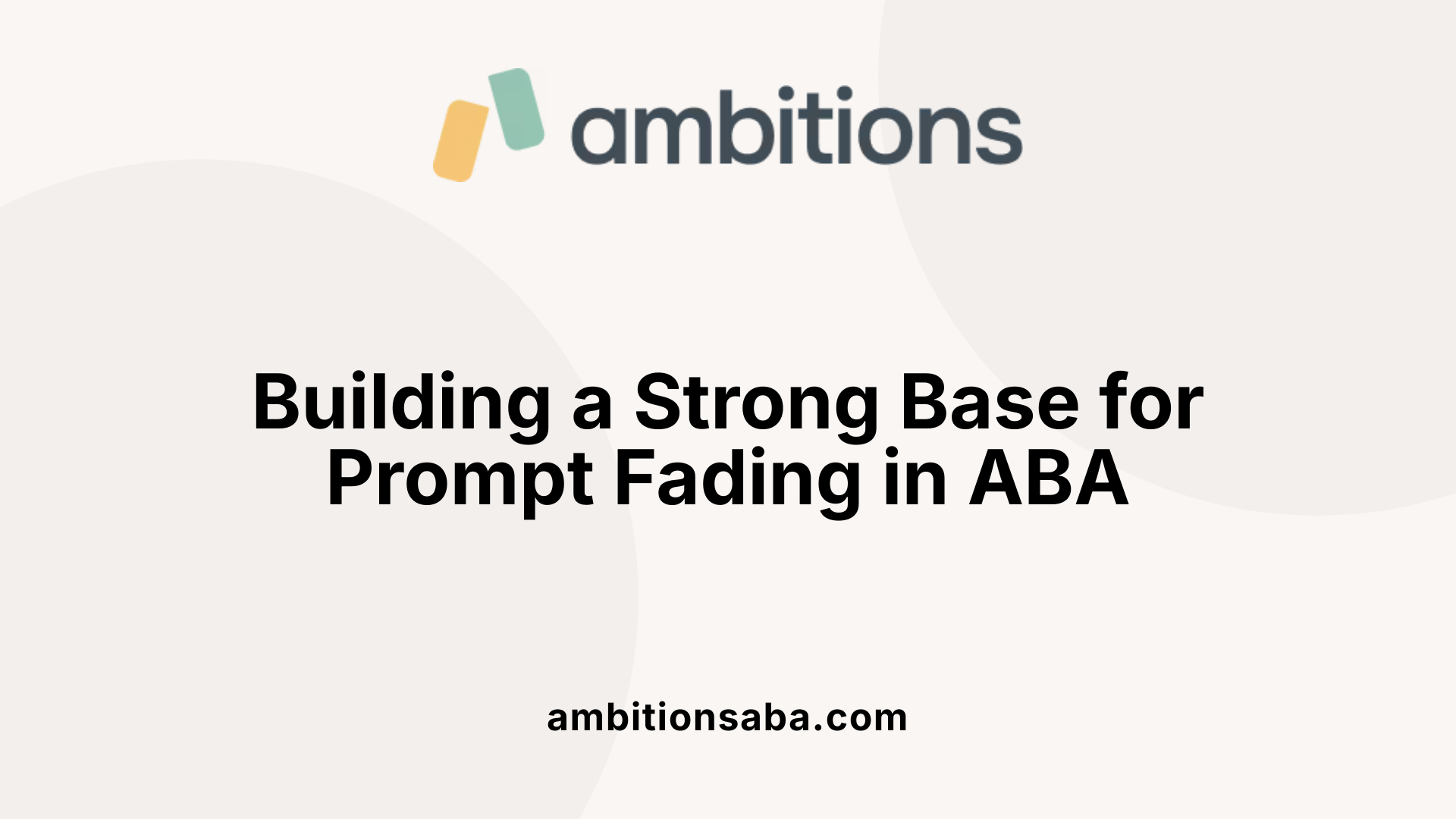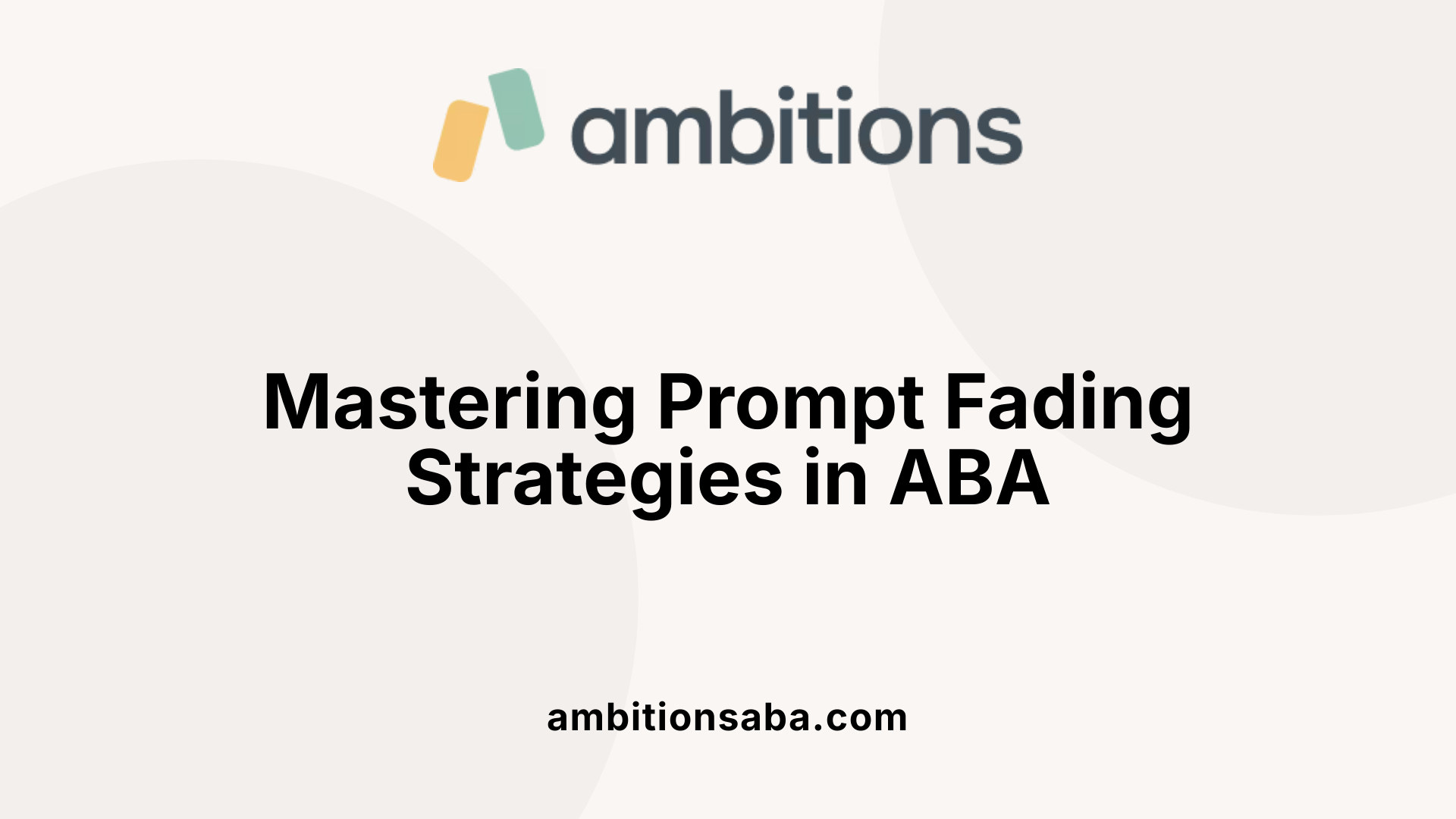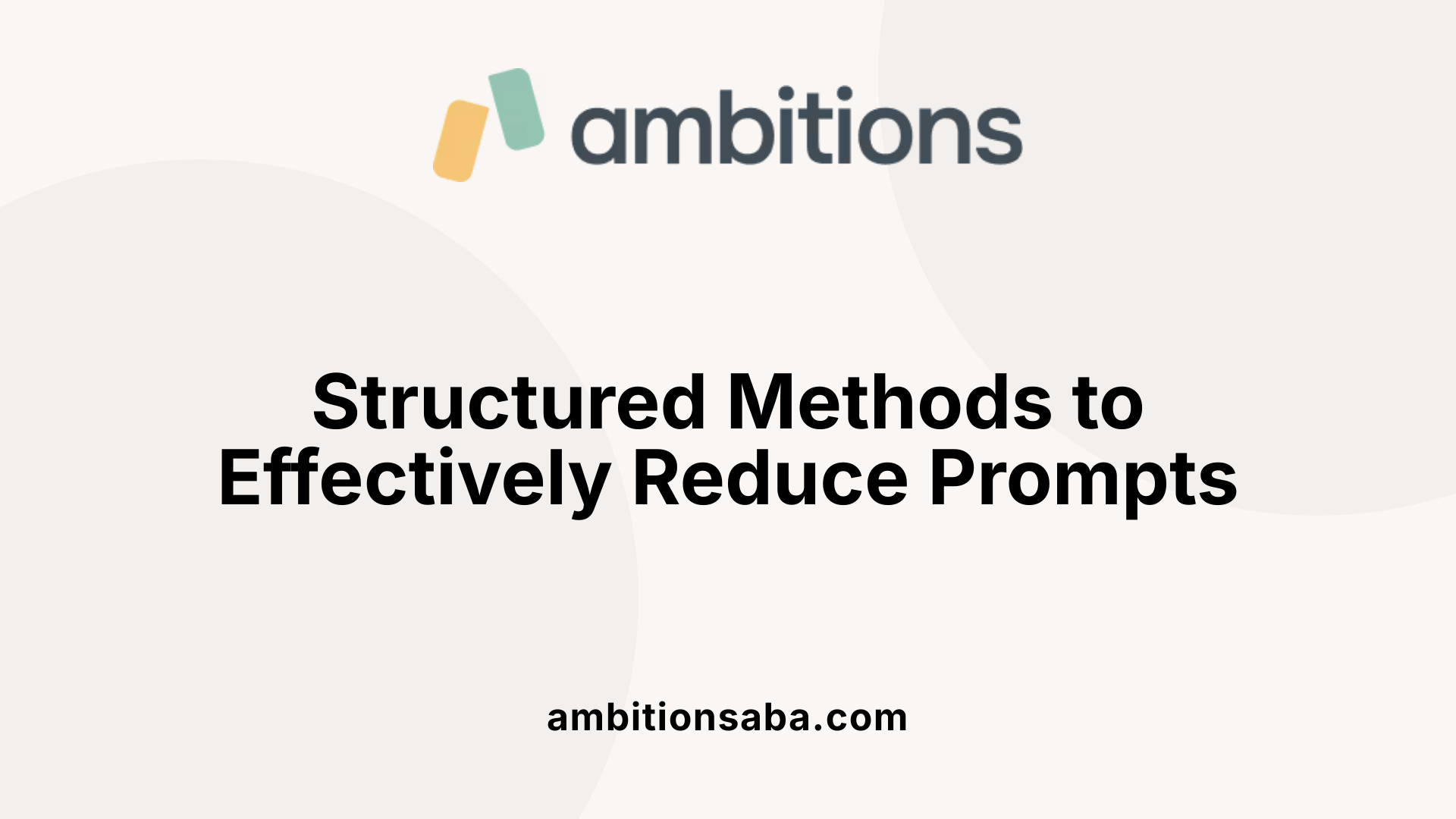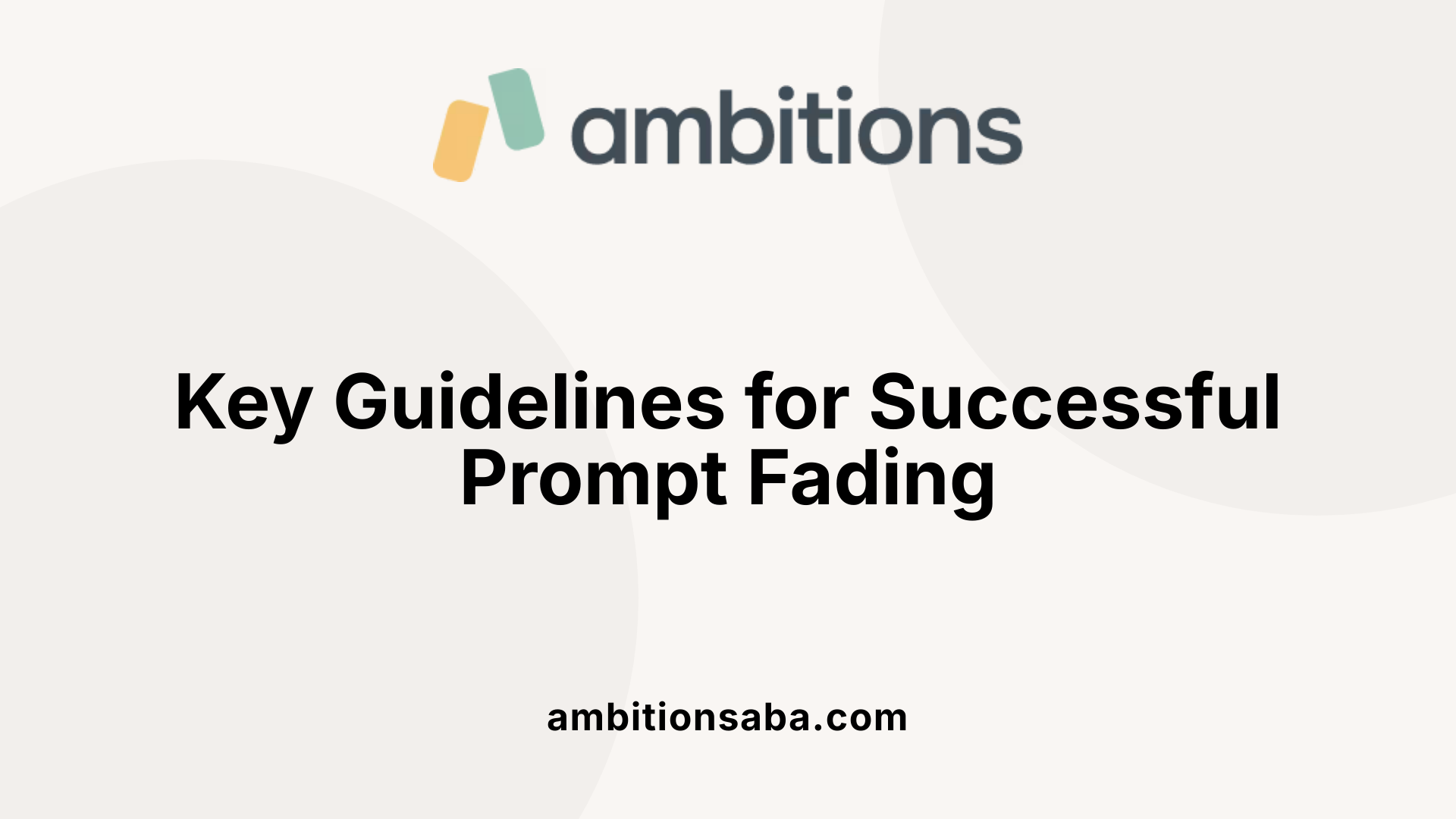Understanding the Foundations of ABA: Key Concepts and Principles
Understanding the Importance of Prompt Fading in ABA
Prompt fading is a crucial component of Applied Behavior Analysis (ABA) that helps individuals achieve independence in performing targeted behaviors. By systematically reducing prompts, educators and therapists facilitate skill mastery while preventing prompt dependency. Effective prompt fading strategies are grounded in research and require careful planning, consistent implementation, and ongoing data collection to ensure successful transfer of stimulus control and generalization of learned skills.
Establishing a Foundation for Prompt Fading in ABA

What are the steps to start ABA prompt fading?
Implementing prompt fading in ABA begins with carefully planning each step. First, identify the specific target behavior you want the learner to perform independently. This clarity helps ensure the intervention is focused and structured.
Next, determine the learner's baseline performance. Observing how they respond without prompts provides valuable data on their current abilities and helps set realistic goals.
Choosing suitable prompts is a crucial step. Prompts can be physical, verbal, visual, or gestural, depending on what best supports the learner's needs. Once prompts are selected, create a prompt hierarchy, starting from the most intrusive prompts (like full physical guidance) to the least (like a slight gesture or verbal cue).
Develop a comprehensive treatment plan that outlines how prompts will be gradually faded. This plan should include specific criteria for moving from one prompt level to the next and strategies for monitoring progress.
After establishing the plan, begin treatment sessions with structured implementation, closely observe responses, and collect data systematically. Regular evaluation of progress allows for adjustments to be made to the fading process, ensuring the learner becomes increasingly independent.
Why is prompt fading essential from the start of intervention?
Starting prompt fading early in ABA intervention is vital because it encourages independent responding and reduces prompt dependency. When prompted behaviors are faded systematically, learners are more likely to transfer skills across different environments and situations.
Integrating prompt fading from the outset supports durable learning, ensuring that skills are maintained without continuous assistance. It also promotes confidence and self-sufficiency, which are critical for generalization and long-term success in skill acquisition.
Techniques and Approaches for Effective Prompt Fading

What are the techniques and strategies for prompt fading in ABA?
Prompt fading applies several structured approaches to support skill acquisition while encouraging independence. Notable methods include most-to-least prompting, which begins with the most intrusive prompts such as physical guidance and gradually reduces assistance as the learner gains competence. Conversely, least-to-most prompting starts with minimal cues like pointing or verbal hints and only increases prompts if the learner responds incorrectly.
Time delay methods introduce a set pause between the natural cue and the prompt, starting from no delay and increasing it over time to promote automatic responding. Graduated guidance specifically involves systematically withdrawing physical support during activities, such as hand-over-hand assistance, in small, manageable steps.
Stimulus fading involves gradually returning a modified or exaggerated stimulus back to its original form or normal size, which helps prevent stimulus dependency. The overarching prompt hierarchy guides these techniques, classifying prompts from independent responses (I) to full physical support (F), allowing practitioners to select the least intrusive effective cue.
All these strategies rely heavily on data monitoring and setting mastery criteria to ensure a seamless transfer of control from prompts to natural responses, thereby fostering genuine independence.
How can educators fade prompts to promote independent responses?
Educators support learners’ independence by carefully decreasing assistance through structured prompt hierarchies. By systematically fading prompts—starting with full physical guidance and reducing it to gestural or verbal cues—learners gradually internalize responses without reliance on external prompts.
Time delay techniques are also crucial. For example, waiting a few seconds before providing a prompt encourages the learner to respond independently first. Fading visual aids or verbal instructions similarly boosts natural responses.
Consistent monitoring and data collection are essential to observe progress and determine when to fade each prompt level. Reinforcing independent responses with high motivation reinforcers further sustains motivation and confidence. Overall, the goal is a carefully paced decrease in assistance that supports lasting, functional independence.
Systematic Methods for Prompt Reduction

How can prompts be systematically decreased to promote independent responses?
Reducing prompts methodically involves a structured approach that prioritizes the use of established prompt hierarchies. These hierarchies include techniques like Most-to-Least and Least-to-Most prompting, which dictate the order in which assistance is faded.
In the Most-to-Least method, staff start with the most intrusive prompts—such as full physical guidance—and gradually move toward less intrusive cues like gestural or verbal prompts. Conversely, the Least-to-Most approach begins with minimal assistance, only increasing prompts if the learner struggles.
A crucial part of systematic fading is following predefined criteria that determine when to reduce or increase prompts. This might include performance levels, consistency, or accuracy over a set number of trials. Regular data collection allows practitioners to monitor progress, identify prompts that are no longer necessary, and ensure the learner can perform tasks independently.
Tailoring the strategy to each learner’s pace improves outcomes. For example, some children may respond well to a gradual decrease from physical prompts to verbal cues, while others might need a slower fading schedule. Consistent application and patience are essential, with prompt levels adjusted based on performance consistency.
Why is data collection so important in prompt fading?
Collecting data provides objective, measurable evidence of how well a learner performs at each prompt level. Using electronic tools simplifies this process, making it easier to track changes over time and across different sessions.
Data helps identify the moment when a prompt can be faded without risking prompt dependence or incorrect responses. For instance, if a learner responds accurately without physical prompts over several sessions, a practitioner may decide to reduce assistance.
Additionally, data allows for quick adjustments to the fading process. If progress stalls or regressions occur, reviewing performance data can highlight the need to pause fading or reintroduce prompts temporarily. This systematic approach helps prevent premature fading, which could hinder learning.
How does monitoring progress guide prompt adjustments?
Consistent observation provides insights into whether the current prompting strategy is effective. Regular monitoring identifies trends and ensures the fading process aligns with the learner’s readiness.
Practitioners look for signs of independence, accuracy, and reduced reliance on prompts. If these indicators are not met, the prompts may need to stay in place longer or be faded more slowly. Conversely, if independence is achieved rapidly, prompts can be increased gradually or eliminated sooner.
Monitoring also helps in maintaining engagement and motivation by ensuring the learner remains challenged yet supported. Tracking progress fosters a data-driven environment, making prompt fading more precise and individualized.
How can prompts be adjusted based on data?
Adjustments should be guided by ongoing data analysis. When data shows consistent success at a certain prompt level, the next step is to fade to a less intrusive prompt. If errors increase or performance declines, prompts may need to be reintroduced or made more intrusive temporarily.
Practitioners often set specific criteria, such as a set number of correct responses or a percentage of accuracy, to determine when to alter prompt levels. For instance, if a learner responds correctly 80% of the time without physical prompts over three sessions, the physical prompt may be faded.
Adjustments should be gradual, ensuring the learner has mastered the skill at each stage before proceeding. Using data-based decisions reduces guesswork and promotes steady progress toward independence.
What does the gradual fading process involve?
The fading process is carefully planned, beginning with the least intrusive prompts and extending toward independence. The process includes several steps:
- Assessment of baseline performance to establish initial prompt levels.
- Creation of a prompt hierarchy tailored to the learner.
- Implementation of a structured plan that specifies when and how prompts will be faded.
- Applying the plan during therapy sessions, ensuring adherence.
- Consistent data recording to monitor responses.
- Adjusting the prompt levels based on the ongoing performance data.
This systematic approach ensures the assistance is decreased gradually, allowing the learner to perform with minimal support. Patience and flexibility are vital, as each learner’s pace of acquiring independence varies.
In summary, systematic prompt fading relies on structured strategies, diligent data collection, and responsive adjustments. Utilizing tools like electronic data collection software, such as the Artemis ABA platform, helps streamline the process, ensuring effective and efficient transitions from guided responses to independent performance.
Practical Examples of Prompt Fading Procedures in ABA
In Applied Behavior Analysis (ABA), prompt fading is a vital strategy to foster independence in learners by systematically reducing assistance. Different prompts and their fading methods are used to tailor interventions for each child's needs.
Fading Physical Prompts
Physical prompts, such as hand-over-hand guidance, are often used early in teaching new skills. Over time, physical assistance is gradually withdrawn through steps like supporting wrists, then touching hands lightly, then touching the forearm or elbow, and finally removing physical contact altogether. For example, when teaching hand clapping, an instructor might initially guide the child's hands but will slowly reduce physical cues as the child becomes more independent.
Fading Verbal Prompts
Verbal prompts involve giving instructions or cues, initially containing full sentences or explicit directions. To encourage independent responses, these prompts are decreased gradually. For instance, initially saying, "Say your name," might be reduced to just starting the first sound or a partial prompt like "Na." Consistently reducing verbal guidance helps the learner respond with less assistance.
Visual Cue Reduction
Visual prompts, such as picture cards or written cues, are also faded over time. As a child learns to recognize and respond to these cues, the visual prompts are lessened—perhaps from a full picture to a partial image or a simplified version. Once the response becomes consistent, visual cues are eliminated altogether.
Stimulus Fading
Stimulus fading involves diminishing the visual or auditory prominence of cues. For example, if a picture prompt is used to teach labeling, gradually reducing its size or contrast helps the learner rely less on the cue itself. Similarly, in drawing tasks, cues in stimulus presentation are faded to encourage independent production.
Proximity Fading
Proximity fading is used during tasks by increasing the physical distance between the cue and the task. For instance, during spatial activities, the instructor may start close to the learner and gradually move farther away, reinforcing the child's ability to perform independently at greater distances.
Data-Driven Adjustments
All these procedures should be guided by meticulous data collection. Using electronic data collection tools or platforms like Artemis ABA allows practitioners to monitor progress and decide when to advance to the next stage of fading. Regularly reviewing this data ensures the transition to independence is smooth and effective.
Ways to Combine Methods
Effective prompt fading usually involves a combination of these strategies tailored to the individual. For example, physical prompt fading might be paired with visual cue reduction, while verbal prompts are also gradually minimized.
| Fading Method | Step Example | Typical Use Case | Data to Monitor | |--------------------------|------------------------------------------------||----------------------------------------------|----------------------------------------------| | Physical Prompt Fading | Wrist support → Light touch → No contact | Teaching gross motor skills | Correct response rate, prompt level used | | Verbal Prompt Fading | Full instruction → First word cue → Independent| Teaching naming or language tasks | Response accuracy, prompt hierarchy progress | | Visual Cue Reduction | Full picture → Partial picture → No image | Labeling, matching tasks | Accuracy, cue reduction points | | Stimulus Fading | Bright/contrast stimulus → Dimmer stimulus | Discrimination tasks | Response accuracy, stimulus size/contrast | | Proximity Fading | Close proximity → Moderate → Faraway | Spatial tasks | Response rate, distance at independence |
Successful implementation depends on consistent application, patience, and use of high reinforcement value. Regular staff training and effective data collection support the decision-making process for prompt fading, ensuring that the learner progresses toward independent performance.
Best Practices and Guidelines for Successful Prompt Fading

What are the best practices and guidelines for prompt fading in ABA?
Successful prompt fading relies on a combination of systematic procedures and individualized approaches. It begins with setting clear, measurable criteria for when and how prompts are reduced. This means defining specific performance levels that indicate readiness for less assistance.
Practitioners should employ structured fading strategies, such as gradually decreasing physical contact, verbal cues, or visual prompts. Collecting data throughout this process is essential; data guides decisions on whether to progress or revert to previous prompt levels.
Flexibility plays a crucial role. Each learner responds differently, so fading should be adjusted based on individual progress. Slow, incremental reductions often prevent prompt dependence and promote true independence.
Consistent monitoring enables practitioners to recognize signs of prompt dependence or frustration early. Reinforcement with motivating rewards—or high-value reinforcers—strengthens independent performance. Employing these reinforcers consistently during fading sessions encourages ongoing progress.
Team training ensures that all staff members understand and uniformly apply fading procedures. Utilizing electronic data collection systems, like the Artemis ABA platform, enhances accuracy and efficiency in tracking progress.
What strategies can prevent prompt dependence during fading?
To avoid prompt dependence, it is vital to establish criterion-based steps for prompt removal. Using natural cues from the environment as prompts helps individuals rely on their own responses rather than external prompts.
Providing high-motivation reinforcers alongside fading encourages children to perform independently. Patience and careful supervision are essential—rushing the process can lead to reliance on prompts.
Applying natural reinforcement, setting realistic goals, and avoiding abrupt prompt removals create a stable environment for skill acquisition. When prompts are faded gradually and systematically, learners develop confidence and true independence.
Overall, the focus is on balancing systematic reductions with ongoing reinforcement, monitoring, and individual responsiveness to foster lasting skill development.
Integrating Prompt Fading into Individualized Interventions
Why should prompt fading be integrated into the overall intervention plan?
Prompt fading is essential to incorporate from the very beginning of intervention planning. It ensures that skill development is systematic, fostering independence rather than dependency on prompts. Proper integration involves training staff effectively, establishing clear procedures, and using consistent data collection to monitor progress. This approach promotes the gradual transfer of skills to natural settings, helping learners perform tasks confidently on their own. Such planning makes interventions more durable, leading to better generalization across different environments and daily routines.
How does prompt fading facilitate skill generalization?
When prompts are systematically reduced, learners gain confidence and mastery in performing skills independently. This consistency across various contexts helps behaviors become more natural and adaptable. As assistance diminishes, behaviors are more likely to transfer beyond the training environment, making skills applicable in real-life situations. Fading helps embed these skills into a child's routine, supporting long-term independence and successful generalization across settings.
Planning and execution of prompt fading
Effective prompt fading involves detailed planning, including selecting appropriate prompts, establishing a hierarchy, and setting clear criteria for when to increase or decrease prompts. Data collection is crucial at each step to inform progress and prevent prompt dependence. Fading should be gradual—starting with the most subtle cues or least intrusive prompts—and adjusted based on individual response patterns. Training staff on proper procedures and maintaining consistency ensures the fading process is smooth and effective.
Methods of prompt fading
Various strategies can be employed, such as Least-to-Most prompting, Most-to-Least prompting, Time Delay, or Graduated Guidance. The choice depends on the learner’s needs and the specific skill targeted. Most-to-Least involves starting with the most intrusive prompts and fading to less intrusive ones, while Least-to-Most begins with minimal assistance. Time Delay increases the time between cue and prompt, encouraging independent responses.
Monitoring and data collection
Ongoing data tracking with tools like electronic software—such as the Artemis ABA platform—helps visualize progress, guide decision-making, and ensure prompts are faded appropriately. Consistent documentation of responses and prompt levels supports adjustments, ensures fidelity in implementation, and maximizes effectiveness.
| Aspect of Prompt Fading | Approach | Description | Benefits |
|---|---|---|---|
| Planning | From the start | Integrate prompt fading into intervention design | Promotes consistency and success |
| Staff Training | Before and during intervention | Teach staff procedures for fading | Ensures correct implementation |
| Data Collection | Continuous | Track responses and prompt levels | Guides adjustments and prevents dependency |
| Methodology | Least-to-Most, Most-to-Least, Time Delay | Choose appropriate strategy | Tailors fading to learner's needs |
| Practice | Gradual reduction | Decrease prompts systematically | Fosters independence |
| Generalization | Across settings | Fade prompts in various environments | Builds durable skills |
Effective prompt fading is a foundation for fostering independence in learners. When planned thoughtfully, executed with precision, and supported by diligent data collection, it enhances the overall success of ABA interventions.
Fostering Independence through Systematic Prompt Fading
Effective prompt fading is a cornerstone of successful ABA therapy, ensuring that individuals attain independence in their behaviors and skills. By applying research-supported methods, maintaining consistent data collection, and following best practices, practitioners can foster durable, generalized responses. A systematic, flexible approach—tailored to each learner—maximizes learning outcomes while minimizing prompt dependence, ultimately leading to greater confidence and autonomy for learners.

